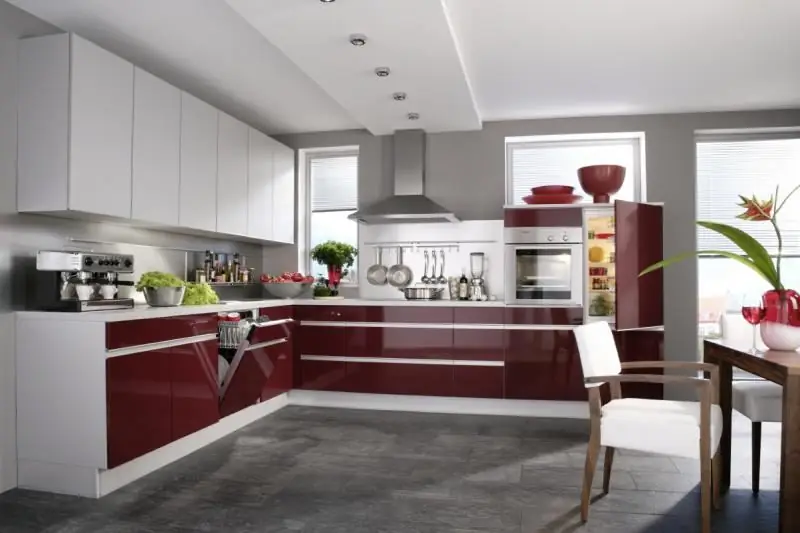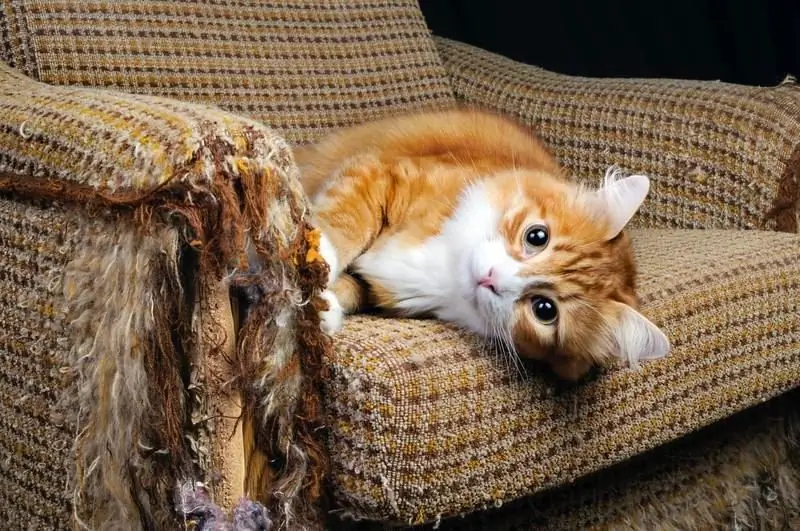
Table of contents:
- Furniture from newspapers: an unusual piece of furniture with your own hands
- Furniture from newspaper tubes: what is needed to create it
- How to make newspaper tubes correctly
- Weaving a tray from newspaper tubes
- DIY furniture for the room: weaving a beautiful chair
- DIY paper furniture: a master class on weaving a house for a cat
- Video about weaving from newspaper tubes
- Author Bailey Albertson [email protected].
- Public 2023-12-17 12:53.
- Last modified 2025-01-23 12:41.
Furniture from newspapers: an unusual piece of furniture with your own hands

Every family probably has a lot of old and unnecessary newspapers, magazines, advertising brochures. They can be used to light a stove or fireplace, they can be recycled. Or you can make furniture and interior decor items from this paper. Yes, do not be surprised, newspapers can serve as a strong and reliable material for weaving.
You have all come across wickerwork. They look nice and airy, but they are quite expensive. Therefore, we offer you some simple options that will allow you to master the technique of wicker weaving using cheap material.
So, we will master weaving furniture with our own hands in order to decorate the house on our own and at no special cost.
Content
- 1 Furniture from newspaper tubes: what is needed to create it
- 2 How to make newspaper tubes correctly
- 3 Weaving a tray from newspaper tubes
- 4 DIY furniture for the room: weaving a beautiful chair
- 5 DIY paper furniture: a master class on weaving a house for a cat
- 6 Video about weaving from newspaper tubes
Furniture from newspaper tubes: what is needed to create it
First of all, we need to find out what we need to work, regardless of what piece of furniture or decor we will create. The list of materials includes:
- Newspapers (magazines, brochures);
- Sheets of cardboard;
- Scissors;
- Pencil;
- Paper cutting knife;
- Glue for paper;
- Scotch;
- Stain and varnish for covering the finished product.

Next, you need to decide what kind of furniture from newspaper tubes or a decor item you want to make.
In this case, you can always do with the means at hand. This can be dishes, furniture legs and much more. If you want to make a wicker chair, the simplest option would be the decoupage technique for a plastic chair, which will serve as a frame.
The first thing to do is to form tubes from newspapers, which will serve as a vine for weaving. The tubes should be of the same length, and most importantly, the diameter. Therefore, wind them on a pencil to get the optimal shape, pre-coating the paper with glue. This will prevent the straw from falling apart after you take the pencil out of it.
From the outside, it may seem that paper is not the most reliable material for making massive items for a specific purpose. But in fact, do-it-yourself paper furniture is quite practical, strong, and if you adhere to all the rules in the manufacture, then it will serve you for many years.
How to make newspaper tubes correctly
To make your newspaper products strong, you need to approach them with great care.
Fold the sheet of newspaper lengthwise twice, cut to make 4 equal strips. To make a straw, take a knitting needle of the appropriate thickness, and attach the strips to the corner at an angle of 20-30 degrees. Holding the edge, twist the tube. Having reached halfway, remove the knitting needle and tighten, gluing the edges with glue.

If during the weaving process you need to build up a tube, do not use glue for this. It is better to leave a gap of 2-3 cm, it is enough to hold the new link. For example, when curling large newspaper sheets, the tube expands upward, this is optimal for extension.
Since paper is much softer than vines, try to tuck the tubes at the end of the weaving and fix them with PVA glue on the product. Leave it overnight to dry, and continue finishing in the morning.
First, let's practice on something simple. For example, a small round tray.
Weaving a tray from newspaper tubes
For such a tray, you will need prepared newspaper tubes and cardboard, as well as some form to support the structure during the weaving process. Stock up on a decoupage napkin with a pattern you like and acrylic paint.

- Cut three circles of the same size out of cardboard.
- Paint one of the circles with white acrylic paint. After drying, do decoupage on it and set aside for a while.
- Draw the second circle into sectors of the same size. Use a protractor for accurate calculations. For example, if you take an angle of 8 degrees for staking, you get 45 rays. Stick tubes on them, they will serve as the basis of the product.
- Now, on top of the base tubes, glue the second circle of cardboard. Thus, you will have the bottom of the product ready.
- Take two tubes and braid the first row with them, precisely adhering to the edge of the cardboard circle so that the ends are closed. Moving to the second row, lift the base tubes vertically. In this case, you will not need a frame for braiding, since the working tubes, from which weaving began, keep their shape well on their own.
- Continue braiding the tray using either the simple tube binding technique, or with a more complex pattern, if this work is not new to you and you have already mastered several patterns.
- After the tray is completely woven, cover it in two layers with varnish, and after it dries, fix a cardboard circle with decoupage to the bottom.
So, you have practiced, filled your hand, and you have a nice and functional interior element. Now let's get down to more complex options.
DIY furniture for the room: weaving a beautiful chair
This is exactly the same version of decoupage of a simple plastic chair, which we talked about above. To do this, you will need:
- Plastic chair;
- Sheets of cardboard;
- Newspaper or paper tubes;
- Glue.

Let's get to work. For convenience, you can put the workpiece on the table, but if it is preferable to work on the floor, place a soft blanket under your feet, since weaving a chair can take a lot of time.
- Place a piece of cardboard under the chair and cut to the desired size, forming the bottom of the future chair. To each side of the resulting shape, glue the newspaper tubes parallel to each other, on the folds - at an angle of about 30 degrees.
- Once the chair is level, lift the tubes, they will serve as uprights. Now take four tubes, secure them to the base and braid the first row as shown in the photos. The extra two tubes need to be hidden inward, and with the remaining two, two more rows are woven.
- After the fourth row has been completed, it is advisable to use two tubes at the same time for weaving. Having weaved several rows in this way, you can return to weaving using the "string" technique. Thus, the bottom and the post of the chair are ready.
- Moving on to work on the seat. It is woven in one tube. For every fifth row, a working tube is left on the right side, and a new one with a margin is added on the left. This is how the side struts are formed.
- The sides of the seat and base are braided together using the rope technique from left to right. After that, the remaining tails from the seat are hidden inward, under the weaving. Proceed to the back: it needs to be woven from new tubes. After several separate rows have been braided, begin braiding the backrest around the chair. To narrow the armrest, take two racks together; one of them can then be cut off.
- Start weaving the back on the left, gluing the ends of the tubes to it and cutting off the excess. From the inside, you will need to reduce the width strictly in the form. Add two bent tubes on the armrest and twist in a circle, bending the work tube on the right side under the first right upright. Cut the ends and glue. To cover the arches of the armrests and backrests, braid the upper section until the upper and lower posts converge. Bend the edges. We cut off the excess.

Now our chair is completely ready, it remains only to cover it with stain and varnish.

DIY paper furniture: a master class on weaving a house for a cat
You love cats? If yes, then for sure you are the owner of this affectionate fluffy animal, and take care of your pet. Why not make a two-level house in which the cat will feel comfortable and cozy. Moreover, a little is needed for this: cardboard and newspaper tubes.
First, pay attention to the size and fatness of your cat. The larger the animal, the denser the newspaper tubes should be and the wider the bottom. Let's consider a standard size: an oval bottom 40 x 35 cm, the first level of the house is 23 cm high.

- The tubes are glued to the bottom at the same distance by the sun. Raise them so that they form a wall and begin to braid. In each row, when weaving, bring the base tubes a little closer to each other so that the walls taper towards the top.
- After 23cm braided, make a few more rows to form a straight stand of about 5cm. A crossbar between floors will be placed here. It must be woven in advance in the form of a circle, and the base tubes should protrude enough beyond the working canvas to connect with the base tubes of the first floor.
- Now braid the resulting compacted base in a circle, forming a semicircular basket from the inside.
It will make the structure heavier, make it strong enough. After the house is dry, open it with stain and varnish.
Video about weaving from newspaper tubes
Now you know how, practically at no cost, to provide yourself with furniture and decorate your home with your own hands. Weaving from newspaper tubes is a very exciting activity that allows you to be creative. If you want to learn something new and interesting about this type of needlework, ask questions in the comments. We will be happy to discuss with our readers everything that interests them!
Recommended:
How To Remove Hair Dye From Clothes, Remove It From Furniture And Other Items + Photos And Videos

How to chemically remove hair dye stains from fabrics, leather goods, carpets, hard surfaces, and wallpaper
How And What To Wash The Blood From The Sofa, Mattress, Upholstered Furniture And Other Items In The Apartment + Photos And Videos

Blood stains can ruin various types of surfaces. We will tell you how to remove them from furniture, wallpaper, ceiling, as well as how to wash them off shoes with improvised means
How To Remove Wax Or Paraffin From Clothes, Wallpaper, Furniture, Plastic And Other Items + Photos, Videos And Reviews

How to get rid of wax, paraffin and stains from clothes, furniture and other surfaces. What tools and methods can be used and how effective they are
High-tech Kitchen And Living Room Interior: Examples Of Design, Choice Of Colors And Materials, Decoration, Furniture, Accessories, Photos, Videos

High-tech style features and how to decorate the kitchen interior. How to choose colors and materials for design and how to combine other styles with high-tech
How To Wean A Cat And A Cat To Tear Wallpaper And Furniture, Features Of Weaning Kittens And Adult Animals, Useful Tips And Tricks, Reviews

Why does a cat tear wallpaper and furniture? How to prevent damage to property. What to do if you can't wean your cat
